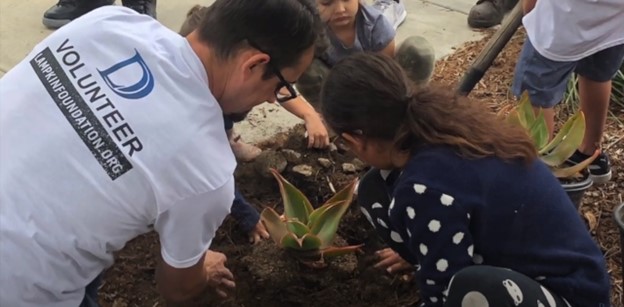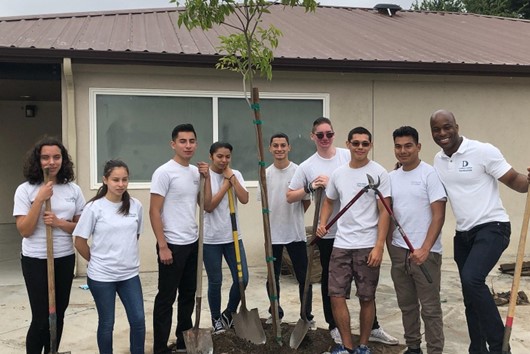Introducing D’Andre Lampkin, a visionary philanthropist and entrepreneur whose transformative efforts in youth education, unwavering commitment to service excellence, active community engagement, and adept response to mental health crises have left an indelible mark. In the forthcoming piece, D’Andre Lampkin, founder of the D’Andre D. Lampkin Foundation, shares insights on the invaluable gift of instilling a profound love for the outdoors in today's tech-centric world. Some of his experience stems from his community role as a Los Angeles County Deputy Sheriff assigned to the Parks Bureau.
With decreasing attention spans and rising rates of childhood obesity, getting kids outside to play and explore has never been more crucial. However, with busy schedules and a lack of green spaces in urban areas, it can be challenging to instill a love for the outdoors in the next generation. Below, readers will learn more on why it is crucial to nurture a love for the outdoors in children and how parents and caregivers can do so.
D’Andre Lampkin Explains the Benefits of Outdoor Play
The benefits of outdoor play for children are numerous. Not only does it allow kids to burn off excess energy and stay physically active, but it also has a positive impact on their mental, emotional, and
social well-being. Spending time outdoors can help improve cognitive abilities, reduce stress and anxiety, and enhance creativity and problem-solving skills. Furthermore, playing outside allows children to develop important social skills such as teamwork, communication, and conflict resolution.
Encouraging Outdoor Exploration
One of the best ways to nurture a love for the outdoors in children is by encouraging them to explore. D’Andre Lampkin of the D’Andre D. Lampkin Foundation says that this can be as simple as taking a walk around the neighborhood or going on a hike in a nearby park. By exposing children to different outdoor environments, they can learn about nature and develop an appreciation for it. Parents and caregivers can also plan fun activities such as
scavenger hunts or nature crafts to make outdoor exploration more exciting and engaging for children.
 Making Time for Outdoor Play
Making Time for Outdoor Play
With busy schedules and a multitude of indoor activities available, it can be challenging to find time for outdoor play. However, it is essential to prioritize outdoor time for children. Setting aside a specific time each day or week for outdoor play can help make it a regular part of a child's routine. D’Andre Lampkin also says that parents and caregivers can incorporate outdoor activities into everyday tasks, such as having a picnic in the park instead of eating at home or taking a walk to the grocery store instead of driving.
Leading by Example
Children often learn best by observing and imitating their elders. D’Andre Lampkin of the Lampkin Foundation explains that it is crucial for adults to also spend time outdoors and model a love for nature. If children see their parents enjoying outdoor activities such as gardening, hiking, or biking, they will be more likely to develop an interest in these activities themselves. Additionally, adults can involve children in the process by encouraging them to join in on outdoor tasks and showing them the importance of caring for the environment.
Embracing Technology-Free Time
D’Andre Lampkin says that in today's digital age, it is nearly impossible to escape technology. Children are often bombarded with screens and gadgets, which can hinder their desire to spend time outdoors. To nurture a love for the outdoors in the next generation, it is crucial to set aside designated technology-free time. This means turning off all screens and encouraging children to engage in outdoor activities instead. Whether it is playing in the backyard, going for a bike ride, or exploring a nearby park, having technology-free time allows children to disconnect and fully immerse themselves in nature.
 The Importance of Green Spaces
The Importance of Green Spaces
D’Andre Lampkin says that green spaces are essential for nurturing a love for the outdoors. Unfortunately, many urban areas lack access to parks and other natural environments, making it challenging for city-dwelling children to engage with nature. As a result, it is crucial for communities and city planners to prioritize creating and maintaining green spaces. Parents and caregivers can also seek out local parks or community gardens to take their children to, providing them with opportunities to connect with nature.
Teaching Environmental Stewardship
It is also crucial to teach children about the importance of environmental stewardship. D’Andre Lampkin of the D’Andre D. Lampkin Foundation notes that as kids spend time outdoors, children can learn about the impact of their actions on the environment and ways to reduce their carbon footprint. Simple activities like picking up litter or planting a tree can help children understand the value of caring for our planet.
Conclusion
Not only does outdoor activity have numerous physical, mental, and social benefits for children, but it also helps foster a sense of responsibility towards our environment. D’Andre Lampkin says that by encouraging outdoor exploration, making time for outdoor play, leading by example, embracing technology-free time, and teaching environmental stewardship, parents and caregivers can help instill a love for nature in their children that will last a lifetime. Let's work together to ensure that the next generation develops a strong connection with the outdoors and embraces all the wonders that nature has to offer. So go outside, breathe in the fresh air, and start exploring! The possibilities are endless.
 Making Time for Outdoor Play
Making Time for Outdoor Play The Importance of Green Spaces
The Importance of Green Spaces